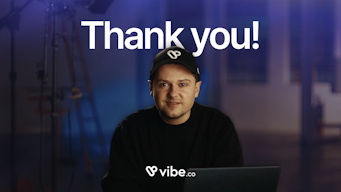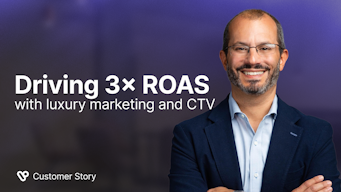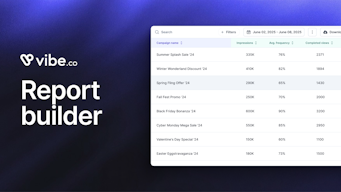How do you calculate video completion rate?
This blog is for you if:
- 📊 You’re tracking video performance but aren’t sure what numbers really matter.
- 🎯 You want to improve your video engagement and measure its success more accurately.
- 🚀 You’re looking to boost your marketing campaigns with better video content strategies.
As someone in advertising, video content creation, or digital marketing, you understand how important video is for connecting with your audience.
But here’s the thing: producing a video is just half the battle. You need to know if your audience is sticking with it.
That’s where video completion rate (VCR) comes in.
In this post, I’ll explain exactly what video completion rate is and why it’s such a crucial metric for your marketing efforts. I’ll also show you:
- How to calculate VCR and use it to measure engagement.
- What video completion rate benchmarks look like across platforms like YouTube, TikTok, and CTV.
- How understanding these numbers can help you improve your content strategy and increase your ROI.
- Practical tips for increasing your video completion rate and keeping viewers engaged until the end.
By the end of this blog, you’ll have a solid grasp of how to track and improve your video completion rate to get better results from your videos.
Let’s get started!
What is Video Completion Rate?
Video completion rate (VCR) measures the percentage of viewers who watch your video from start to finish. This is an important metric because it tells you how engaging your content is.
You might also hear about the view-through rate (VTR). While VCR tracks full views, VTR measures how many people watched a certain portion of your video.
So, why does the video completion rate matter? VCR helps you understand if your audience is staying engaged or dropping off at certain points in your video.
👉A high VCR means your content keeps viewers interested, while a low VCR signals that your video might not be engaging enough.
Now, you might be wondering: What is a good video completion rate?
While it varies across platforms, a completion rate of 70-80% is generally considered strong for most types of videos.
Tracking VCR gives you insights into how well your content is performing. For example, if your VCR is low, it could indicate a need to make the video shorter, more engaging, or better targeted.
In marketing, higher video completion rates often lead to better outcomes, like
- more shares,
- improved brand recall, and
- ultimately better ROI.
By focusing on improving your VCR, you can enhance the effectiveness of your video campaigns.
Now that you know what video completion rate is and why it’s important, let’s talk about how to calculate it.
How Do You Calculate the Video Completion Rate?
To calculate the video completion rate (VCR), you’ll need two key pieces of data: view-throughs and impressions.
The basic formula is: VCR = (View-Throughs ÷ Impressions) × 100
- View-throughs- These are the number of times people watched your video from start to finish without skipping any parts.
- Impressions represent how many times people started playing the video.
You can find both of these metrics in your analytics dashboard.
👉Here’s an example:
Let’s say 6,000 people watched your video all the way through.
At the same time, 20,000 people started the video but didn’t finish.
Using the formula: VCR = (6,000 ÷ 20,000) × 100 = 30%
This means your video completion rate is 30%.
Now, you can use this formula across different platforms to understand how your video performs on each one.
For example, YouTube may show different VCRs than Connected TV (CTV). This comparison helps you adjust your content strategy based on platform performance.
Next, we will learn why advertisers measure video completion rate.
Why Do Advertisers Measure Video Completion Rate?
Measuring video completion rate (VCR) helps advertisers in several key areas.
Here's how:
- Understanding Audience Engagement:
- Tracking VCR lets you know how well your video holds viewers' attention.
- Higher VCR means better engagement, while lower VCR suggests you may need to improve your content.
- Improving ROI for Video Marketing Campaigns:
- Videos with higher VCR deliver better returns on investment.
- If viewers watch your video all the way through, they are more likely to take action, increasing your campaign’s success.
- Informing Platform Algorithms:
- Platforms like Facebook and YouTube use VCR to decide which videos to promote.
- Videos with higher VCR are favored by algorithms and shown to more users, giving you more exposure.
- Connecting VCR to Audience Retention:
- A high VCR indicates your audience finds the content valuable and interesting.
- Retention is critical for maintaining long-term relationships with your audience and encouraging repeat views.
- Impact on Sales and Conversions:
- If viewers watch your video to the end, they are more likely to convert.
- A high VCR shows that your video has successfully communicated its message and driven action, such as purchases.
As you can see, measuring VCR is essential for optimizing video campaigns and understanding audience behavior.
But what exactly qualifies as a good video completion rate? Let’s learn that next.
What is a Good Video Completion Rate?
A good video completion rate (VCR) depends on where you’re posting your video and what type of content it is.
Here's a breakdown of average VCRs across different platforms:
| Platform | Ad Completion Rate | Organic Video Completion Rate |
|---|---|---|
| YouTube | 15% to 30% | 40% to 60% |
| Facebook & Instagram | 10% to 25% | Higher, varies by content |
| Connected TV (CTV) | 30% to 50% | Up to 97% |
This table shows the VCR benchmarks across platforms, but let’s find out why VCR’s vary.
- YouTube: Ads on YouTube usually have a VCR between 15% and 30%.
Organic content (videos users choose to watch) has a higher VCR, often 40% to 60%. People skip ads but tend to stay longer for content they’re interested in.
- Facebook & Instagram: Ads on Facebook and Instagram usually have a VCR of 10% to 25%.
People scroll quickly, so they may not watch the full video. Organic videos that is content users choose typically have a higher VCR because users watch them intentionally.
- TikTok: TikTok videos have a very high VCR, usually around 80%. Since TikTok videos are short and engaging, users often watch them from start to finish.
- Connected TV (CTV): Ads on CTV platforms (like Vibe, Roku, and Apple TV) generally have a VCR between 30% and 50%.
However, organic content on CTV can have up to 97% completion because users watch it like they would a TV show.
Now that we've clarified what constitutes a good video completion rate on different platforms let’s move forward with strategies to help you improve your VCR and boost viewer engagement across all your content.
How to Improve Your Video Completion Rate
Improving your video completion rate (VCR) is key to engaging your audience. Here are some strategies you can apply:
- Shorten Video Length: Keep your videos short and to the point. The quicker you grab attention, the less likely people drop off.
- Optimize for Mobile: A lot of viewers watch videos on their phones. Make sure your video looks good on smaller screens.
- Target the Right Audience: You must tailor your content to the interests of your specific audience. This way, viewers are more likely to stick around.
- Create Engaging Thumbnails & Captions: The thumbnail is the first thing people see. It must grab their attention and entice them to click.
- Leverage Interactive Features: You should use polls, CTAs, or questions to engage viewers and encourage them to stay through to the end.
By following these steps, you can increase the chances that viewers will watch your videos till the end.
Which Channels Have the Highest Video Completion Rates?
The platform you choose has a huge impact on your video completion rate (VCR).
Different platforms offer different user experiences, and each affects how long people stay engaged with your videos.
Below, we'll break down the top platforms by VCR performance.
Video Completion Rates Across Platforms
| Platform | Content Type | Average VCR | Why It Works |
|---|---|---|---|
| CTV (Vibe) | Long-form content | 97% | Immersive, TV-like experience |
| YouTube | Organic videos | 40% - 60% | Active viewer choice, relevant content |
| Ads | 15% - 30% | Skippable ads lead to lower VCR | |
| TikTok | Organic short-form videos | 80% | Short, highly engaging videos |
| Facebook/Instagram | Organic videos | 25% - 40% | Active participation, but fast scrolling |
| Ads | 10% - 25% | Quick scrolls and ad skippability |
Here are the key insights from the above table
- CTV Platforms (Vibe): Platforms like Vibe, Roku, Amazon Fire TV, and Apple TV have the highest VCRs, with rates reaching up to 97%.
- The immersive, TV-like experience on CTV keeps viewers engaged longer, making it an excellent choice for long-form content.
- Vibe stands out here for its interactive content experience, which makes users watch until the very end.
- YouTube: On YouTube, VCRs are quite different depending on the content type.
- Organic videos (videos people choose to watch) tend to have higher VCRs, ranging between 40% and 60%.
- In contrast, YouTube ads (which are skippable) usually see lower completion rates between 15% and 30%.
- TikTok: TikTok’s short-form videos—usually under one minute—see completion rates of up to 80%.
- Since TikTok content is designed to keep users scrolling, the VCR is high, especially for videos that fit users' interests.
- Facebook and Instagram: For both Facebook and Instagram, organic content tends to perform better than ads.
- Organic videos often see 25% to 40% VCR, while ads typically see 10% to 25%.
- The key factor here is the fast-paced nature of these platforms, where users scroll quickly through their feeds.
Conclusion
Now that you’ve learned about video completion rates and how they vary across platforms, here’s the takeaway:
- Shorten Video Length: Keep things brief to hold viewers’ attention.
- Target the Right Audience: Make sure your videos speak to the people who care.
- Engage with Thumbnails and Captions: First impressions count, so make your video preview stand out.
- Interactive Features: Polls, questions, and CTAs keep people hooked.
And if you're looking for a platform that delivers high VCR and audience engagement, Vibe is the way to go.
With immersive TV-like experiences, Vibe's platforms can help you hit up to 97% video completion rates.
Remember, platforms like YouTube, TikTok, and even Facebook have their own benchmarks, but for long-form content, Vibe offers the best results.
So, if you're ready to take your video content to the next level, reach out to us today.



